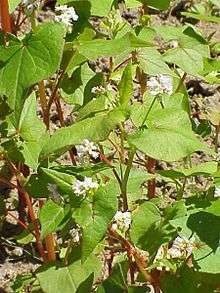Fagopyrum
The genus Fagopyrum is in the flowering plant family Polygonaceae. It includes some important food plants, such as F. esculentum (buckwheat) and F. tataricum (Tartary buckwheat). The genus is native to the Indian subcontinent, much of Indochina, and central and southeastern China. Species have been widely introduced elsewhere, throughout the Holarctic and parts of Africa and South America.[2]
| Fagopyrum | |
|---|---|
 | |
| Fagopyrum esculentum | |
| Scientific classification | |
| Kingdom: | Plantae |
| Clade: | Tracheophytes |
| Clade: | Angiosperms |
| Clade: | Eudicots |
| Order: | Caryophyllales |
| Family: | Polygonaceae |
| Subfamily: | Polygonoideae |
| Genus: | Fagopyrum Mill.[1] |
| Species | |
|
See text. | |
| Synonyms[2] | |
| |
Description
Fagopyrum contains 15 to 16 species of plants, including two important crop plants, buckwheat (Fagopyrum esculentum), and Fagopyrum tataricum (Tartary buckwheat). The two have similar uses, and are classed as pseudocereals, because they are used in the same way as cereals but do not belong to the grass family Poaceae.
Within Fagopyrum, the cultivated species are in the Cymosum group, including Fagopyrum cymosum or perennial buckwheat,[3] the artificial hybrid Fagopyrum × giganteum,[4] and Fagopyrum homotropicum.[5]
This genus has five-petaled flowers arranged in a compound raceme that produces laterally flowered cymose clusters.[6]
Taxonomy
The genus Fagopyrum was first published by Philip Miller in 1754.[1] It is placed in the tribe Fagopyreae (as the only genus) in the subfamily Polygonoideae.[7]
Species
As of March 2019, Plants of the World Online accepted the following species:[2]
- Fagopyrum callianthum Ohnishi
- Fagopyrum capillatum Ohnishi
- Fagopyrum caudatum (Sam.) A.J.Li
- Fagopyrum crispatifolium J.L.Liu
- Fagopyrum cymosum (Trevir.) Meisn.
- Fagopyrum densivillosum J.L.Liu
- Fagopyrum esculentum Moench
- Fagopyrum gilesii (Hemsl.) Hedberg
- Fagopyrum gracilipedoides Ohsako & Ohnishi
- Fagopyrum gracilipes (Hemsl.) Dammer
- Fagopyrum homotropicum Ohnishi
- Fagopyrum jinshaense Ohsako & Ohnishi
- Fagopyrum kashmirianum Munshi
- Fagopyrum × kuntzei Beck
- Fagopyrum leptopodum (Diels) Hedberg
- Fagopyrum lineare (Sam.) Haraldson
- Fagopyrum longzhoushanense J.R.Shao
- Fagopyrum luojishanense J.R.Shao
- Fagopyrum macrocarpum Ohsako & Ohnishi
- Fagopyrum pleioramosum Ohnishi
- Fagopyrum pugense T.Yu
- Fagopyrum qiangcai D.Q.Bai
- Fagopyrum rubrifolium Ohsako & Ohnishi
- Fagopyrum statice (H.Lév.) Gross
- Fagopyrum tataricum (L.) Gaertn.
- Fagopyrum tibeticum (A.J.Li) Adr.Sanchez & Jan.M.Burke
- Fagopyrum urophyllum (Bureau & Franch.) Gross
- Fagopyrum wenchuanense J.R.Shao
- Fagopyrum zuogongense Q.F.Chen
See also
References
- "Plant Name Details for Fagopyrum Mill". The International Plant Names Index. Retrieved 2019-03-08.
- "Fagopyrum Mill.". Plants of the World Online. Royal Botanic Gardens, Kew. Retrieved 2019-03-08.
- PFAF Plant Database: Fagopyrum dibotrys (Perennial Buckwheat)
- Chen, Qing-Fu; Huang, Xiao-Yan; Li, Hong-You; Yang, Li-Juan & Cui, Ya-Song (2018). "Recent Progress in Perennial Buckwheat Development". Sustainability. 10 (2): 536. doi:10.3390/su10020536.
- T. Sharma; S. Jana (2002). "Species relationships in Fagopyrum revealed by PCR-based DNA fingerprinting". Theoretical and Applied Genetics. 105 (2–3): 306–312. doi:10.1007/s00122-002-0938-9. PMID 12582533.
- M. Quinet; V. Cawoy; I Lefevre; F. Van Miegroet; A-L. Jaquemart; J.-M. Kinet. (2004). "Inflorescence structure and control of flowering time and duration by light in buckwheat (Fagopyrum esculentum Moench)". Journal of Experimental Botany. 55 (402): 1509–1517. doi:10.1093/jxb/erh164. PMID 15208346.
- Schuster, Tanja M.; Reveal, James L.; Bayly, Michael J. & Kron, Kathleen A. (2015), "An updated molecular phylogeny of Polygonoideae (Polygonaceae): Relationships of Oxygonum, Pteroxygonum, and Rumex, and a new circumscription of Koenigia", Taxon, 64 (6): 1188–1208, doi:10.12705/646.5